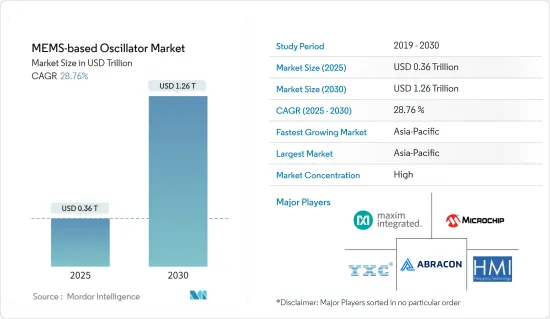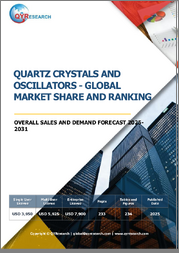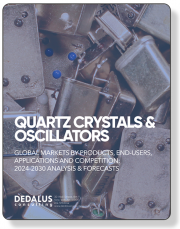
|
시장보고서
상품코드
1685926
MEMS 오실레이터 : 시장 점유율 분석, 산업 동향 및 통계, 성장 예측(2025-2030년)MEMS-based Oscillator - Market Share Analysis, Industry Trends & Statistics, Growth Forecasts (2025 - 2030) |
||||||
MEMS(마이크로 전자 기계 시스템) 오실레이터 시장 규모는 2025년 3,600억 달러로 추정되고, 2030년에는 1조 2,600억 달러에 이를 것으로 예측되며, 예측 기간(2025-2030년) CAGR은 28.76%를 보일 전망입니다.

세계의 MEMS 오실레이터 시장은 최종 이용 산업에서 제품 수요가 증가함에 따라 가속화되고 있습니다.
주요 하이라이트
- MEMS 오실레이터는 순간을 측정할 수 있는 매우 안정적인 기준 주파수를 생성하는 데 도움이 되는 타이밍 장치의 일종입니다. 정보 교환 관리, 타이밍 평가, 무선 주파수 설명, 전자 기기 주문 등을 위해 이러한 비교 주파수가 자주 사용됩니다.
- 또한 MEMS와 실리콘 기반 기술은 넓은 주파수 범위에서 작동하고 주파수 점프에 덜 민감하며 기계적 충격, 진동 및 온도 변화에 대한 내성이 뛰어납니다. 따라서 이 기술은 견고하고 고성능이며 프로그래밍이 가능한 소형 타이밍 솔루션을 개발하는 데 유용합니다.
- 예를 들어, 마이크로칩의 실리콘 MEMS 오실레이터 DSC1001은 1-150MHz, 전원 전압 1.8-3.3VDC, 온도 범위 -40-105℃ 등 폭넓은 전원 전압과 온도에 대응하고 있습니다. 이 디바이스는 10ppm의 낮은 지터와 안정성 성능을 제공합니다.
- MEMS 오실레이터 개발에는 높은 R&D 비용으로 인해 시장에서 활동하는 기업의 수가 제한되어 MEMS 오실레이터 개발이 줄어들 수 있습니다. 시장의 기존 업체들은 차세대 실리콘 타이밍 시스템 솔루션을 설계하고 개발하는 데 상당한 R&D 노력을 기울이고 있습니다.
- 코로나19는 주파수 제어 장치 생산에 큰 영향을 미쳐 자동차, 가전제품, 항공우주 산업 전반에서 완제품 출하가 지연되었습니다. 유명 반도체 공장의 폐쇄로 인해 공급망은 심각한 타격을 입었습니다. 하지만 호흡기 진단 및 코로나19 환자 모니터링을 연구하기 위한 기타 연구 도구 등 미세 유체역학 및 압력이 코로나19와 연관되면서 의료 모니터링용 MEMS 오실레이터 장치가 수혜를 입었습니다.
MEMS 오실레이터 시장 동향
소비자 가전 부문이 상당한 시장 점유율을 차지
- 오실레이터는 진동하는 수정(압전 재료)의 기계적 공명을 활용하여 특정 주파수의 전기 신호를 발생시키는 전자 회로입니다. MEMS 오실레이터는 프로그래밍 가능한 아키텍처를 기반으로 하는 완전한 타이밍 시스템입니다. 또한 기능 개선, 성능 향상, 전자 기기 소형화에 힘입어 수요가 크게 증가하고 있습니다. 오실레이터는 에너지 변화에 따라 두 사물 사이의 주기적인 변동인 발진 규칙에 따라 작동합니다. 컴퓨터, 스마트 워치, 모바일 시스템 및 기타 여러 장치에서 MEMS 오실레이터를 사용합니다.
- 휴대용 및 웨어러블 전자기기의 증가로 인해 모든 전자 부품, 특히 오실레이터의 에너지 소비량과 설치 공간을 줄여야 할 필요성이 커지고 있습니다. 마이크로 전자 기계 시스템(MEMS) 기술을 기반으로 하는 오실레이터는 정확한 주파수 생성과 저전력 소비를 결합하여 클록 회로에서 점점 더 인기를 얻고 있습니다.
- 게다가 타이티엔은 2022년 5월, 저전력 소비 설계, 작은 크기, 높은 정밀도를 특징으로 하는 웨어러블 기기와 사물 인터넷(IoT) 장치에 널리 사용될 수 있는 전류 소비량이 1.4μA에 불과한 초저전류 수정 오실레이터 OZ-D와 OY-D를 출시했습니다.
- MEMS 타이밍 기술 전반의 혁신은 웨어러블 용도의 물리적 공간과 전력 절감에 크게 기여하는 동시에 신뢰성을 향상시킵니다. 이러한 경우 비용은 해당 부문이 소비자 범주에 속하기 때문에 중요한 과제가 됩니다. 또한, 특히 소비자 시장에서 5G 네트워크가 출시됨에 따라 소비자 가전용 소형, 고주파수 지원, 타이밍 슬로프가 적은 MEMS 오실레이터에 대한 수요가 증가할 것으로 예상됩니다.
가장 빠르게 성장하는 시장이 될 것으로 예상되는 아시아태평양
- 아시아태평양 지역은 중국, 일본, 인도, 한국 등의 국가로 인해 주요 지역 시장이 되고 있습니다. 피트니스 활동, 스마트 시계, 의료용 모니터 및 기기 등과 같은 웨어러블 기술에 대한 수요 증가가 이 지역에 기반을 둔 조직의 기반이 되고 있습니다. 이 요인은 아시아태평양 지역의 MEMS 기반 오실레이터 시장의 상당한 성장 잠재력을 나타냅니다.
- 게다가 이 지역에서는 소비 업그레이드가 추진력을 얻고 기술에 정통한 소비자가보다 편리하고 기술 중심의 삶을 수용하기 위해 이러한 가제트에 기꺼이 비용을 지불함에 따라 이 지역의 지능형 웨어러블이 유행이되고 있습니다.
- 풍부한 원자재 가용성과 저렴한 설립 및 인건비도 기업들이 이 지역에 R&D 및 생산 센터를 설립하는 데 도움이 되었습니다. 예를 들어 교토에 본사를 두고 있는 전자기기 제조업체인 교세라는 2021년 1월 가고시마현 기리시마시의 고쿠부 캠퍼스에 새로운 연구개발센터를 건설한다고 발표했습니다.
- 또한 이 시장에서 사업을 전개하는 기업은 시장의 요구를 수용하고 고객 기반을 확대하기 위해 인수 및 통합, 신제품 제공, 협업, 파트너십, 사업 확장 등 다양한 성장 전략을 채택하고 있습니다.
MEMS 오실레이터 산업 개요
MEMS 오실레이터 시장은 전방 및 후방 통합이 가능하고 상당한 수익 창출 능력을 갖춘 대규모 공급업체가 있습니다. 연구 대상 시장은 고도로 통합되어 있으며, 벤더들은 다른 기업보다 기술 역량과 경쟁 우위를 확보하기 위해 R&D에 점점 더 많은 비용을 지출하고 있습니다. 공급업체들은 가격보다는 기술과 품질로 경쟁하고 있습니다. 또한 대부분의 제조업체가 제품을 제조하고 조립하기 위해 이 용량의 가용성에 의존하기 때문에 타사 주조 및 조립 용량에 대한 경쟁이 치열합니다.
2022년 9월 : SiTime Corporation은 회사의 고급 MEMS 기술을 기반으로 하는 독자적인 차량용 오실레이터 시리즈를 발표했습니다. 재 설계된 차동 오실레이터는 내구성이 10배 향상되어 가혹한 주행 조건과 온도 하에서 ADAS의 신뢰성을 보장합니다. 최신 차량용 오실레이터 AEC-Q100 SiT9396/7의 데뷔로 SiTime의 서비스 대상 시장(SAM)은 5,000만 달러 확대됩니다.
2022년 7월 : Abracon LLC(아브라콘)는 Genstar Capital이 인수했다고 발표했습니다. Genstar는 산업, 금융 서비스, 의료, 소프트웨어 업계의 대상 부문에 대한 투자에 중점을 둔 사모 펀드입니다.
기타 혜택
- 엑셀 형식 시장 예측(ME) 시트
- 3개월간의 애널리스트 지원
목차
제1장 서론
- 조사의 전제조건과 시장 정의
- 조사 범위
제2장 조사 방법
제3장 주요 요약
제4장 시장 인사이트
- 시장 개요
- 업계의 매력도 - Porter's Five Forces 분석
- 공급기업의 협상력
- 구매자의 협상력
- 신규 참가업체의 위협
- 대체품의 위협
- 경쟁 기업간 경쟁 관계의 강도
- 업계 밸류체인 분석
- COVID-19가 시장에 미치는 영향의 평가
- MEMS 오실레이터 채택 시 주요 검토 사항
제5장 시장 역학
- 시장 성장 촉진요인
- 실리콘 기반 제조 및 패키징 기술의 발전
- 시장의 과제
- 높은 R&D 비용으로 이어지는 복잡한 설계
- 시장 기회
- 보다 뛰어난 타이밍 장치에 대한 수요를 창출하는 5G의 출현
제6장 시장 세분화
- 유형별
- 온도 보상 오실레이터(TCXO)
- 스펙트럼 확산 오실레이터(SSXO)
- 전압 제어 오실레이터(VCXO)
- 디지털 제어 오실레이터(DCXO)
- 기타 유형
- 최종 사용자 산업별
- 자동차
- 항공우주 및 방위
- 소비자 가전
- IT 및 통신
- 기타 최종 사용자 산업
- 지역별
- 북미
- 유럽
- 아시아태평양
- 세계 기타 지역
제7장 경쟁 구도
- 기업 프로파일
- Maxim Integrated Products Inc.(Analog Devices Inc.)
- Microchip Technology Inc.
- HMI Frequency Technology
- Shenzhen Yangxing Technology Co. Ltd
- Abracon LLC
- TXC Corporation
- SiTime Corporation
- Daishinku Corporation
- Rakon Limited
제8장 투자 분석
제9장 시장의 미래
HBR 25.04.04The MEMS-based Oscillator Market size is estimated at USD 0.36 trillion in 2025, and is expected to reach USD 1.26 trillion by 2030, at a CAGR of 28.76% during the forecast period (2025-2030).

The MEMS oscillator market is accelerated due to increased demand for products from end-use industries worldwide.
Key Highlights
- MEMS oscillators are a class of timing apparatus that help create extremely stable reference frequencies that can measure moments. In order to manage information exchange, assess the timing, describe radio frequencies, and place orders for electronic devices, these comparison frequencies are frequently used.
- MEMS and silicon-based technologies also operate over a broad frequency range, are less sensitive to frequency jumps, and are highly resistant to mechanical shock, vibration, and temperature changes. As a result, this technology has been helpful for developing small-sized timing solutions that are also robust, high-performing, and programmable.
- For instance, the silicon MEMS-based oscillator DSC1001 from Microchip offers a broad range of supply voltages and temperatures, including 1MHz to 150MHz with supply voltages between 1.8 and 3.3 VDC and temperature ranges up to -40C to 105C. The device offers jitter and stability performance as low as 10ppm.
- The high R&D costs involved in the development of MEMS oscillator is poised to limit the number of companies operating in the market, which may lead to fewer developments of MEMS oscillators. The established players in the market put significant R&D efforts into designing and developing next-generation silicon timing systems solutions.
- The COVID-19 outbreak had a significant impact on the production of frequency control devices, causing delays in the shipping of finished goods across the automotive, consumer electronics, and aerospace industries. Due to the closure of well-known semiconductor factories, the supply chain was severely harmed. However, as microfluidics and pressure are connected to COVID-19, including respiratory diagnostics and other research tools to study COVID-19 patient monitoring, MEMS-based oscillator devices for medical monitoring applications have benefited.
MEMS-Based Oscillator Market Trends
The Consumer Electronics Segment Holds Significant Market Share
- Oscillators are electronic circuits that develop an electrical signal of a particular frequency by utilizing the vibrating crystal's (piezoelectric material) mechanical resonance. MEMS oscillators are complete timing systems based on a programmable architecture. It further witnesses significant demand aided by improved functionality, enhanced performance, and electronic device miniaturization. An oscillator works on the regulations of oscillation, a periodic fluctuation between two things based on energy changes. Computers, smartwatches, mobile systems, and many other devices use MEMS oscillators.
- The rise in portable and wearable electronics drives the need to reduce the energy consumption and footprint of all electronic components, especially oscillators. Oscillators based on Micro-Electro-Mechanical Systems (MEMS) technology combine accurate frequency generation with low power consumption and are becoming increasingly popular in clock circuits.
- MEMS oscillators offer an appealing combination of low power consumption, small size, high performance, and physical robustness, making them ideal for numerous applications, specifically in portable and wearable electronics. Further, cell phones, computers, watches, radios, and many other devices depend on their success on an electronic oscillator that delivers the output with a precise frequency to develop timing pulses and synchronize events.
- Moreover, in May 2022, TAITIEN launched ultra-low current crystal oscillators, OZ-D and OY-D, with current consumption of only 1.4μA, featuring a low power consumption design, small size, and high precision, that can be widely used in wearable gadgets and the Internet of Things (IoT) devices.
- Innovations across MEMS timing technology significantly contribute to physical space and power savings in wearable applications while improving reliability. Cost in such cases presents significant challenges as the segment falls into the consumer category. Further, with the advent of 5G network rollouts, particularly in consumer markets, the demand for compacter, higher frequency enabled, less timing slop-based MEMS oscillators for consumer electronics is expected to grow.
Asia-Pacific is Expected to be the Fastest Growing Market
- The Asia-Pacific is becoming a primary regional market, owing to the presence of countries such as China, Japan, India, and South Korea. The foundation of organizations based out of the region includes the rising demand for wearable technology such as fitness activities, smart watches, medical monitors/devices, etc. This factor indicates the considerable growth potential for the MEMS-based Oscillator Market in the Asia-Pacific region.
- In addition, intelligent wearables in the region are becoming fashionable as consumption upgrade is gaining momentum and tech-savvy consumers are willing to pay for such gadgets to embrace a more convenient and tech-driven life.
- The abundant availability of raw materials and the low establishment and labor costs have also helped companies launch their R&D and production centers in the region. For instance, Kyocera, a Kyoto, Japan-based electronics manufacturer, announced the construction of a new research and development center in January 2021 at its Kokubu campus in Kirishima City, Kagoshima, Japan.
- Players operating in the market have also adopted various growth strategies, such as acquisitions and integrations, new product offerings, collaborations, partnerships, and business expansions to accommodate the market's needs and expand their customer base.
MEMS-Based Oscillator Industry Overview
The MEMS-based oscillator market has large-scale vendors capable of backward and forward integration and significant revenue generation capabilities. The market studied is highly consolidated, and vendors increasingly spend on R&D to gain technological capabilities and a competitive edge over other enterprises. The vendors are competing on technology and quality but not on price. Also, there is significant competition for third-party foundry and assembly capacity as most manufacturers depend on this capacity's availability to manufacture and assemble their products.
In September 2022: SiTime Corporation unveiled a unique automotive oscillator series based on the company's sophisticated MEMS technology. The redesigned differential oscillators are ten times more durable and assure ADAS reliability in harsh driving conditions and temperatures. The debut of the newest automotive oscillator, AEC-Q100 SiT9396/7, extends the SiTime serviced available market (SAM) by USD 50 million.
In July 2022: Abracon LLC (Abracon) announced that Genstar Capital had acquired it. Genstar is a private equity firm focused on investments in targeted segments of the industrials, financial services, healthcare, and software industries.
Additional Benefits:
- The market estimate (ME) sheet in Excel format
- 3 months of analyst support
TABLE OF CONTENTS
1 INTRODUCTION
- 1.1 Study Assumptions and Market Definition
- 1.2 Scope of the Study
2 RESEARCH METHODOLOGY
3 EXECUTIVE SUMMARY
4 MARKET INSIGHTS
- 4.1 Market Overview
- 4.2 Industry Attractiveness - Porter's Five Forces Analysis
- 4.2.1 Bargaining Power of Suppliers
- 4.2.2 Bargaining Power of Buyers
- 4.2.3 Threat of New Entrants
- 4.2.4 Threat of Substitute Products
- 4.2.5 Intensity of Competitive Rivalry
- 4.3 Industry Value Chain Analysis
- 4.4 Assessment of the Impact of COVID-19 on the Market
- 4.5 Key Considerations for Adopting MEMS Oscillators
5 MARKET DYANAMICS
- 5.1 Market Drivers
- 5.1.1 Advancement in Silicon-based Manufacturing and Packaging Techniques
- 5.2 Market Challenges
- 5.2.1 Complex Designs Leading to High R&D Costs
- 5.3 Market Opportunities
- 5.3.1 Emergence of 5G creating Demand for Better Timing Devices
6 MARKET SEGMENTATION
- 6.1 By Type
- 6.1.1 Temperature Compensated Oscillator (TCXO)
- 6.1.2 Spread Spectrum Oscillator (SSXO)
- 6.1.3 Voltage Control Oscillator (VCXO)
- 6.1.4 Digitally Controlled Oscillator (DCXO)
- 6.1.5 Other Types
- 6.2 By End-user Industry
- 6.2.1 Automotive
- 6.2.2 Aerospace and Defense
- 6.2.3 Consumer Electronics
- 6.2.4 IT and Telecom
- 6.2.5 Other End-user Industries
- 6.3 By Geography
- 6.3.1 North America
- 6.3.2 Europe
- 6.3.3 Asia-Pacific
- 6.3.4 Rest of the World
7 COMPETITIVE LANDSCAPE
- 7.1 Company Profiles
- 7.1.1 Maxim Integrated Products Inc. (Analog Devices Inc.)
- 7.1.2 Microchip Technology Inc.
- 7.1.3 HMI Frequency Technology
- 7.1.4 Shenzhen Yangxing Technology Co. Ltd
- 7.1.5 Abracon LLC
- 7.1.6 TXC Corporation
- 7.1.7 SiTime Corporation
- 7.1.8 Daishinku Corporation
- 7.1.9 Rakon Limited



















